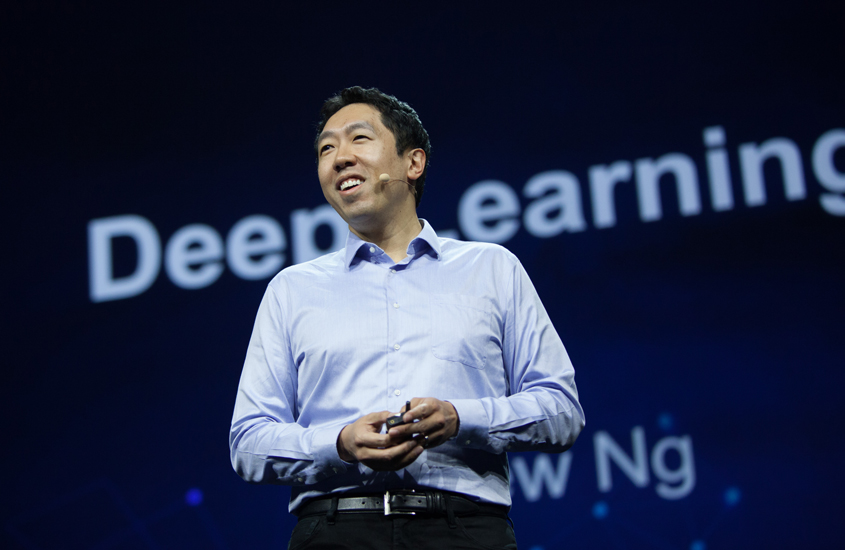By Catherine Jewell, Publications Division, WIPO
The British-born computer scientist, Andrew Ng, is a leading thinker on artificial intelligence (AI) and has been a pioneer in its application for many years. He founded the Google Brain project, served as Chief Scientist at Baidu, and co-founded the online learning platform, Coursera. Today, in addition to his academic work at Stanford University (USA), Mr. Ng is heading up two startups: Landing AI, which works with enterprises to adopt AI, and deeplearning.ai, an AI education company. Mr. Ng recently spoke with WIPO Magazine about the transformative power of AI, and the measures required to ensure that AI benefits everyone.

Why is AI attracting so much attention?
AI is the new electricity. It will transform every industry and create huge economic value. Technology like supervised learning is automation on steroids. It is very good at automating tasks and will have an impact on every sector – from healthcare to manufacturing, logistics and retail.
When you talk about AI, what exactly do you mean?
Much of the economic value generated by AI today is driven by “supervised learning,” which is really good at figuring out simple input–output, or A to B responses, and mapping them. When you join up lots of input-output pairs, this is called deep learning. Deep learning is really good at image recognition, speech recognition and natural language processing. Today, the technology’s most lucrative application is probably determining whether consumers will click on an advertisement. Large online platforms are using this technology to create enormous economic value.
But supervised learning and other AI techniques can do much more. For example, we can input a satellite image of an area, and generate an output that tells us whether it is poverty-stricken and needs more resources. We can input data from a city, and generate an output that identifies areas with the greatest risk of gas leaks. Or we can build more accurate climate change models. There are huge untapped AI opportunities in sectors like agriculture, healthcare and manufacturing.
AI is the new electricity. It has the potential to transform every industry and to create huge economic value
Earlier this year, WIPO launched the first report in the WIPO Technology Trends Series on AI. Why is this important?
The WIPO Technology Trends Report offers a clearer understanding of growth trends in AI, and who is using this technology and in which parts of the world. For example, it shows that until now, only a small number of regions and organizations have focused on AI technology. The report also reveals that deep learning is the biggest and fastest growing technique in AI. While great progress has been made with deep learning in terms of collecting more data and creating more powerful computers to make it work, we still have a long way to go. Effective “unsupervised learning” – learning without labelled data – will be very important.

So are there any downsides to AI?
AI will have an impact on some jobs. To ensure that AI reaches its full potential, drives tremendous global economic growth, and that the fruits of AI are shared fairly, we need government, educators and businesses to work together.
What role can governments play in ensuring AI delivers on its promise?
Governments must invest heavily in education to give citizens a path to success in this AI-powered future. That doesn’t mean simply asking people to work harder, it means asking them to study harder. We need to give people an opportunity to learn the skills they need for an AI-powered society. Today, society needs more AI engineers, but it also needs more healthcare workers, caregivers and teachers. It also needs more wind turbine technicians. There are many important roles to fill and we need to help individuals step into those roles so they can participate in the exciting AI future that we are building. At a time when AI is disrupting many jobs and industries, governments have an important role to play in helping individuals succeed, contribute to and reap the rewards of this AI-powered economy.
If governments, universities and corporations work together to encourage education and innovation, then all nations and all people have an almost unlimited opportunity to be part of this new AI economy
Do governments need to regulate AI?
Thoughtful regulation will be important. For AI to reach its full potential, governments should be thoughtful about protecting citizens, while also creating room for the positive innovation that AI can bring. Take for example, the US start-up, Zipline that uses drones – computer controlled airplanes – to deliver blood. One of the main reasons why Zipline launched its drone service in Rwanda was because of the regulatory clarity that exists in Rwanda. What we are seeing over time is that governments with more thoughtful policies that allow AI-innovations into their economies will create value for their citizens more rapidly and thereby help grow their economies.
About WIPO Technology Trends 2019 – Artificial Intelligence
The WIPO Technology Trends report provides a common information base on AI for policy and decision makers in government, business and others, who are grappling with the ramifications of a new technology that promises to transform many areas of economic, social and cultural activity.
Among the report’s findings:
- Since the emergence of AI in the 1950s up to the end of 2016, innovators and researchers filed applications for nearly 340,000 AI-related inventions and published over 1.6 million scientific publications.
- AI-related patenting is growing rapidly, with more than half of the identified inventions published since 2013.
- Companies represent 26 out of the top 30 AI patent applicants. Universities and public research organizations account for the remaining four.
- International Business Machines Corp. (IBM), (USA), had the largest portfolio of AI patent applications at the end of 2016, followed by Microsoft Corp., (USA), Toshiba Corp., (Japan), the Samsung Group (Republic of Korea) and NEC Group (Japan).
- Chinese Organizations account for three of the four academic players featuring in the top 30 patent applicants, with the Chinese Academy of Sciences ranked 17.
- Machine learning is the dominant AI technique disclosed in patents, included in more than one-third of all identified inventions.
- Deep learning, a machine-learning technique that includes speech recognition systems, is the fastest growing AI technique.
- Computer vision, which includes image recognition, is the most popular AI application, mentioned in 49 percent of all AI-related patents.
- The transportation sector, including autonomous vehicles, is among the fields with the fastest rates of AI-related growth.
- Significant growth rates were also registered in telecommunications, life and medical sciences (esp. robotic surgery and drug personalization) and personal devices, computing and human-computer interaction.
What role can educators play?
We need to build a society of life-long learners where we constantly update our skills and knowledge. The availability of online digital learning tools and content, such as those offered by Coursera, can now let many more people gain knowledge much more inexpensively than was possible with traditional analogue-based models of instruction. At Coursera, 45 percent of learners come from developing economies. Many organizations are working hard to ensure they can deliver digital content to learners around the world.
In addition to pure online digital models of education, blended learning models show great promise. With blended learning, some content is delivered on line with classroom time reserved for students to participate in much richer discussions with professors or their peers. If you let a computer do what it does best – record and deliver multiple types of content – it is possible to free up instructors’ time to deliver education in a way that is much more inexpensive and scalable than traditional methods of instruction. I hope education institutions worldwide will embrace ideas like blended learning and the flipped classroom because the world needs us to deliver high-quality education to many more people.
And the corporate sector?
For many years, developing countries have been asked to climb a predictable ladder (e.g. starting with textiles, moving up to low-end manufacturing and then to high-end manufacturing and eventually manufacturing high-end electronics). One of the problems with AI is that we may be automating away the lower rungs of this ladder. But developing economies still need a way to climb the ladder so they can educate their citizens and enable them to move to higher value jobs and grow their economies. With corporations, governments and universities working together I hope we can replace the ladder with a trampoline and give people the education they need to take advantage of the opportunities that AI offers.
What advice do you have for policymakers in developing countries?
Don’t re-invent the wheel. For example, I would not recommend that a small country builds the next great search engine. We already have multiple great search engines. Most of the inventions and most of the value to be created through AI have not yet been realized. There is still a huge opportunity for everyone, including developing economies, to own a piece of the AI pie. My advice to government leaders of developing nations is to focus on their strengths. For example, if you have a strong mining industry, build AI solutions for mining, because your country will have huge advantages in finding AI solutions to mining compared to a Silicon Valley company. Or if your country is a large coffee exporter, work on AI technologies to optimize how you farm, process and export coffee beans. Again, you have huge advantages in doing that for your local economy. Markets are increasingly global and with AI and an Internet connection, I think it is possible for almost everyone to improve their core industries and provide better products to the world.
Is leadership important?
In moments of technological disruption, leadership matters. Here in the United States we once trusted our government to put a man on the moon. And we did it. The AI world is immature, even the leading cities for AI – Silicon Valley (USA) and Beijing (People’s Republic of China) – do not have mature AI ecosystems because the field is just too new. So if governments, universities and corporations work together to encourage education and innovation, all nations and all people have an opportunity to be part of this new AI economy.



